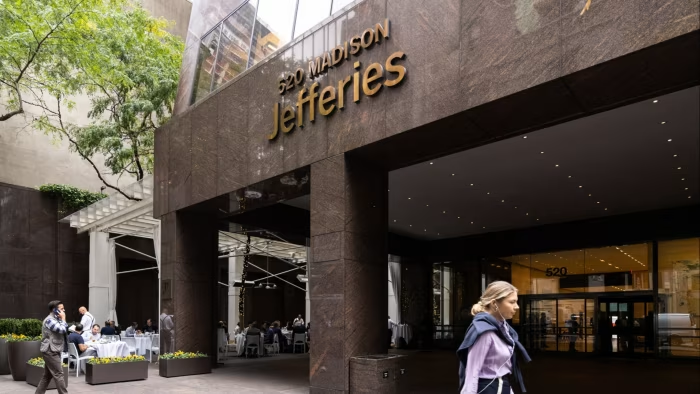The CEO and President warn that financial exposure tied to First Brands could hit Jefferies over time.
The ripples of First Brands Group’s financial collapse are spreading far beyond the auto parts industry, now reaching Jefferies Financial Group, one of Wall Street’s most influential mid-tier investment firms. In a candid note to shareholders this week, Jefferies CEO Richard Handler and President Brian Friedman acknowledged that the firm’s exposure to First Brands could translate into real financial pain over the coming quarters.
The warning came during Jefferies’ latest earnings call, where the leadership addressed growing concerns about its lending and investment ties to the bankrupt manufacturer. Handler didn’t mince words, saying, “We continue to evaluate the full scope of our exposure, but it’s clear that First Brands’ restructuring may impact us more than initially projected. We’re being realistic about potential losses.”
That statement sent quiet tremors through financial circles, given Jefferies’ reputation for managing risk with surgical precision. The firm has long positioned itself as a disciplined, mid-sized powerhouse — agile enough to compete with bigger banks, yet prudent enough to avoid the kind of contagion that sank other financial players in the past. But this time, the warning feels different: First Brands’ bankruptcy may be the firm’s most high-profile misstep in recent years.
According to regulatory filings, Jefferies was a key lender and financial adviser to First Brands Group during its acquisition spree between 2020 and 2023. The company, known for brands like FRAM, Rain-X, and Raybestos, financed much of its growth through leveraged debt, backed by Jefferies and a handful of private equity partners. At the time, the deals looked like a solid bet: First Brands’ sales were steady, and demand for car maintenance parts was resilient, even through inflation and supply-chain disruptions.
But as the market shifted and interest rates climbed, the company’s balance sheet began to crumble. When First Brands filed for Chapter 11 bankruptcy earlier this year, it left a trail of unpaid obligations — and Jefferies, reportedly, with hundreds of millions in exposure.
While the firm hasn’t disclosed the exact figure, analysts estimate Jefferies’ potential loss could be between $250 million and $400 million, depending on the outcome of First Brands’ restructuring. In the context of Jefferies’ overall portfolio, that’s not catastrophic — but it’s significant enough to sting, especially amid tighter margins and investor scrutiny.
Handler and Friedman’s transparency, though rare in Wall Street culture, reflects the firm’s long-standing preference for forthright communication. In their joint memo, the executives wrote, “We take accountability seriously. First Brands’ situation was unforeseen in its severity, but we remain confident in our broader credit strategy. This event, while costly, will not define us.”
Still, investors weren’t reassured. Jefferies’ stock slipped nearly 4% in post-market trading, as analysts began recalculating risk factors tied to the firm’s credit exposure. “Markets hate uncertainty,” said Jennifer Kim, a banking analyst at MorganEdge. “Even if Jefferies can absorb the hit, the bigger concern is whether this signals a broader issue with middle-market lending practices — especially in an environment where corporate debt is piling up faster than earnings.”
Indeed, Jefferies isn’t the only financial institution feeling the heat from First Brands’ collapse. Several private lenders and hedge funds that participated in the same debt deals are now scrambling to recover collateral or restructure terms. But Jefferies, due to its advisory and lending dual role, is viewed as the most exposed.
Internally, sources describe the mood as “calm but vigilant.” The firm has reportedly set up a dedicated task force to manage its exposure, negotiate with creditors, and explore recovery options through asset sales or settlements. Jefferies’ executives have emphasized that the situation is “manageable” and that the firm’s capital position remains strong, backed by record revenue from its investment banking and trading arms.
However, this episode also highlights a broader issue plaguing the financial sector: the rising risk of leveraged lending. In recent years, Jefferies and other mid-sized banks have leaned heavily into lending to private companies — a lucrative business but one with thin margins for error. With interest rates at multi-year highs and consumer demand softening, more of these borrowers are struggling to stay afloat.
“This could be a canary in the coal mine,” warned Mark Delaney, senior analyst at Fitch Ratings. “If a firm as operationally disciplined as Jefferies is feeling the pressure, it suggests that middle-market credit exposure is a ticking time bomb for many institutions.”
Despite the headwinds, Handler appeared determined to project control. During the call, he reiterated that Jefferies’ core businesses — M&A advisory, trading, and asset management — remain strong, with record deal pipelines expected for the next quarter. “We’ve navigated far worse,” he said confidently. “Our strategy remains unchanged: prudent risk, long-term relationships, and transparency with our stakeholders.”
Yet behind that confidence lies a clear message — the age of easy corporate credit is over. What’s unfolding with First Brands is not just a company’s collapse, but a symptom of a larger financial recalibration. The era of high-yield lending to debt-laden firms is giving way to tighter scrutiny, and Jefferies’ experience may serve as a warning to others chasing returns in risky waters.
For now, the firm’s leadership insists the damage will be contained. But among analysts and investors, the sentiment is mixed. “Handler and Friedman are straight shooters,” said Kim. “If they’re saying this might hurt over time, believe them. It’s not just about First Brands — it’s about what this says for every lender tied to fragile companies.”
As the bankruptcy proceedings continue, Jefferies finds itself balancing financial caution with reputational recovery. The First Brands fallout may not sink the firm, but it’s certainly a reminder that even the sharpest financial players aren’t immune to the ripple effects of corporate overreach.
Or as one industry insider put it with a wry grin, “When the tide goes out, you find out who lent too much — and who’s still pretending not to notice.”







